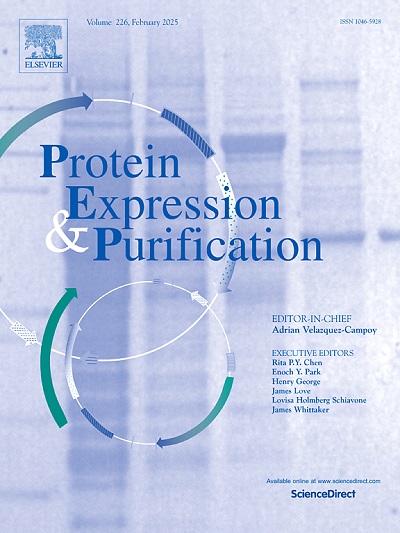枯草芽孢杆菌转化玉米赤霉烯酮ZPH13磷酸转移酶的特性研究
IF 1.2
4区 生物学
Q4 BIOCHEMICAL RESEARCH METHODS
引用次数: 0
摘要
玉米赤霉烯酮(ZEN)是一种由镰刀菌产生的霉菌毒素,由于其残留在玉米及其工业副产品中,对人类和动物构成相当大的健康风险。迫切需要有效的方法来控制或消除ZEN。本文从ZEN污染的饲料样品中分离到枯草芽孢杆菌Z1Y3菌株,该菌株能够高效转化ZEN。该菌株在15 h内完全转化了5 mg/L的ZEN。随后,在其基因组中鉴定出ZEN磷酸转移酶基因ZPH13。该基因在大肠杆菌BL21 (DE3)中异源表达,并对重组蛋白ZPH13进行了生化表征。该酶在35℃、pH 8.0条件下活性最佳,在0.5 h内转化2 μg/mL ZEN。利用皮提亚修饰蛋白稳定性,通过自由能计算(ΔΔG)确定潜在的稳定热点,筛选得到有益突变体N371I和N371T,提高了酶的活性和稳定性。通过高效液相色谱-四极杆萃取-质谱分析,发现ZEN通过磷酸转移酶活性转化为玉米赤霉烯酮-磷酸(ZEN- p)。此外,与未经处理的ZEN相比,转化产物与T-47D人乳腺导管癌(T47D)细胞共培养显示出明显降低的毒性。这些发现通过创新的酶发现和蛋白质工程策略建立了霉菌毒素转化的新范式。本文章由计算机程序翻译,如有差异,请以英文原文为准。
Characterisation of ZPH13 phosphotransferase from Bacillus subtilis in zearalenone transformation
Zearalenone (ZEN), a mycotoxin produced by Fusarium species, poses considerable health risks to humans and animals because of its residues in maize and its industrial byproducts. Effective methods to control or eliminate ZEN are urgently needed. Herein, Bacillus subtilis strain Z1Y3, capable of efficient ZEN transformation, was isolated from ZEN-contaminated feed samples. This strain completely transformed 5 mg/L ZEN within 15 h. Subsequently, a ZEN phosphotransferase gene, ZPH13, was identified in its genome. The gene was heterologously expressed in Escherichia coli BL21 (DE3), and the recombinant ZPH13 protein was biochemically characterised. The enzyme exhibited optimal activity at 35 °C and pH 8.0, achieving transformation of 2 μg/mL ZEN within 0.5 h under these conditions. Pythia was used to modify protein stability, identifying potential stabilization hotspots through free energy calculations (ΔΔG) and screening to obtain beneficial mutants N371I and N371T, which improved both enzyme activity and stability. Enzymatic transformation product analysis via ultra-high-performance liquid chromatography–quadrupole exactive–mass spectrometry revealed that ZEN was transformed into zearalenone-phosphate (ZEN-P) via phosphotransferase activity. Furthermore, co-culturing T-47D Human Breast Ductal Carcinoma (T47D) cells with the transformation products demonstrated a considerably reduced toxicity compared to that of untreated ZEN. These findings establish a new paradigm for mycotoxin transformation through innovative enzyme discovery and protein engineering strategies.
求助全文
通过发布文献求助,成功后即可免费获取论文全文。
去求助
来源期刊

Protein expression and purification
生物-生化研究方法
CiteScore
3.70
自引率
6.20%
发文量
120
审稿时长
32 days
期刊介绍:
Protein Expression and Purification is an international journal providing a forum for the dissemination of new information on protein expression, extraction, purification, characterization, and/or applications using conventional biochemical and/or modern molecular biological approaches and methods, which are of broad interest to the field. The journal does not typically publish repetitive examples of protein expression and purification involving standard, well-established, methods. However, exceptions might include studies on important and/or difficult to express and/or purify proteins and/or studies that include extensive protein characterization, which provide new, previously unpublished information.
 求助内容:
求助内容: 应助结果提醒方式:
应助结果提醒方式:


